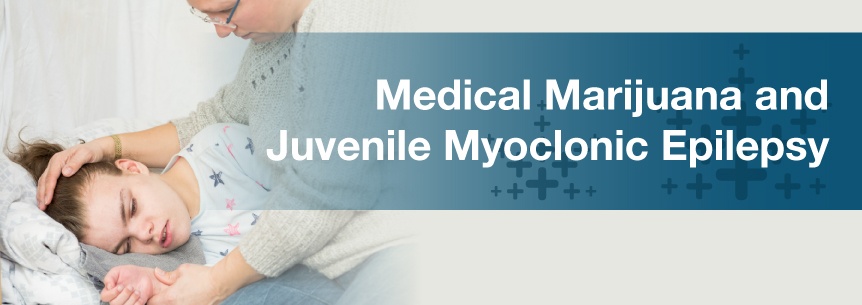
The science on medical marijuana treatment for epilepsy is still ongoing, but so far the results have been promising. Governments have approved epilepsy as a qualifying condition for medical marijuana in more than 40 states. Additionally, researchers are now studying medical cannabis for juvenile myoclonic epilepsy in earnest, and with compelling results.
Juvenile myoclonic epilepsy (JME) is a form of epilepsy that begins in the childhood years or sometimes teenage years. Those who have it wake up from sleep with their legs and arms making quick, jerking movements. You refer to these as “myoclonic jerks.”
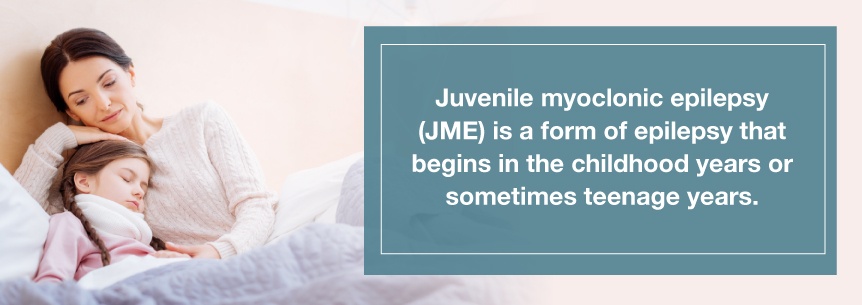
Individuals who don’t suffer from epilepsy have probably experienced those jerks that jar you from sleep, usually when you’re starting to fall asleep. But individuals with JME typically experience other forms of seizures as well.
The seizures tend to improve around the age of 30 years old. JME can also improve with medication, but those with this condition will likely have to take medication for their entire lifetime, even if their seizures stop.
Juvenile myoclonic epilepsy is the most common form of the generalized epilepsy syndromes emerging in childhood. You characterize it by absence seizures (once called “petit mal seizures”), generalized tonic-clonic seizures (once called “grand mal seizures”) and myoclonic seizures.
Individuals with JME experience three different types of seizures. These are:
The symptoms you experience will depend on the type of seizure you have with JME. Symptoms include:
JME seizures occur in the morning within 30 minutes of waking up or after a nap. They’re more likely to occur if the child is experiencing stress.
Doctors aren’t sure exactly why some individuals get JME. However, it could be tied to certain genes running in the family. Around a third of individuals with JME have a relative with seizures. Mutations in one of a few genes can increase susceptibility or cause this condition.
The most studied genes are the EFHC1 gene and the GABRA1 gene, although researchers have identified mutations in at least three other genes in individuals with JME. Many people with JME don’t have any mutations in any of these particular genes. Also likely involved in JME are changes in other, so-far unidentified genes.
There’s an association with EFHC1 gene mutations and JME in a small number of individuals. Researchers have seen the GABRA1 gene mutation in a few members of a large family with JME.
Among the fascinating aspects of JME is that there are a couple of extremely common seizure-precipitating factors: stress and sleep deprivation.
Fatigue and sleep deprivation, mainly after drinking excessively, are the strongest precipitants of generalized tonic-clonic seizures and myoclonic jerks in JME.
Other common precipitating factors are:
Some individuals with JME have seizures triggered by flickering light like strobe lights, video games, TV or light reflecting off the ocean waves or shining through the trees. You refer to these as “photosensitive seizures.” Performing calculations or making decisions can provoke myoclonic seizures occasionally.
Seizure medications can typically control seizures fairly well and studies show seizures often improve after a person gets into their 40s. Even when the individual is free of seizures, they need to continue their seizure medication due to a high recurrence risk (especially those with more severe types). For most individuals, treatment is lifelong.
Patients with juvenile myoclonic epilepsy often demonstrate non-compliance to the prescriptions their doctors give them. They forget to take their medicine regularly or attend control visits, even when they claim they’re doing everything. Such inadequate behavior (aggravation of intellectual and executive functions) might link with long-term anxiety. Therefore, it demonstrates the harmful cognition effects of a longer duration of the disease and early onset of a seizure.
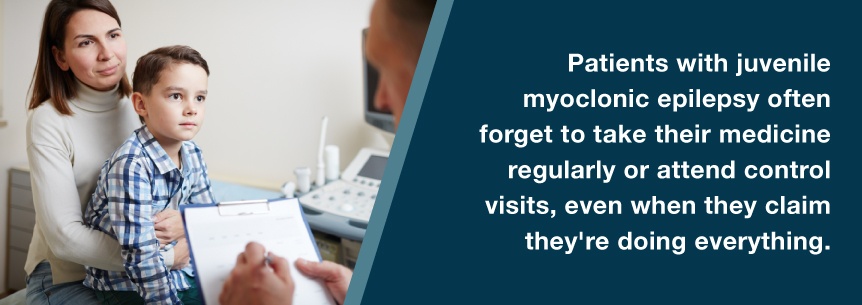
These disorders’ causes might be naturally accompanied nonpsychotic psychiatric conditions, often seen in JME, according to the International Journal of Biomedicine. These conditions include a variety of types of:
Additionally, seizures in social situations decrease social interaction and thereby affect the quality of interpersonal relationships. Psychiatric disorder incidences in almost a third of individuals with JME are similar to those individuals with temporal lobe epilepsy report, where scientists have studied psychiatric aspects more often. These disorders aggravate the individual’s condition further, creating a vicious cycle.
Some facts about JME from the Epilepsy Foundation include:
The U.S. National Library of Medicine estimates for juvenile myoclonic epilepsy include:
Pritchard described “myoclonus” in 1822 as “a symptom linked with epilepsy.” In 1854, Delasiave called it “petit mal moteur.” Herpin provided the first detailed description in 1867 of a patient with JME, naming the myoclonic jerks “secousses.”
Physicians diagnose juvenile myoclonic epilepsy using an electroencephalogram (EEG) — a test used for finding unusual brain wave patterns. The doctor performs the test while you’re awake and asleep.
The doctor places electrodes on your scalp to perform the test. These electrodes connect to a computer that shows your brain’s electrical activity. The results look like wavy lines or spikes. The doctor scans them to find patterns signaling JME.
The doctor might also want to do an imaging test of your brain like an MRI or CT scan to check for any other possible causes of your seizures. The generalized and partial seizures JME causes are usually treated differently.
The doctor will base treatment on:
Common medications prescribed are:
Anti-epileptic (anti-seizure) medicines are often extremely helpful. It may take a few tries to find the proper medication and dosage. The doctor will work closely with you to find the best treatment and watch for side effects. Common side effects of anti-seizure medications are:
Another option of treatment if medications aren’t controlling your seizures is Vagus Nerve Stimulation (VNS).
A Food and Drug Administration (FDA) advisory panel recommended approval unanimously of a medication for epilepsy made with an ingredient in cannabis. This drug will be the first marijuana-derived prescription medication available in the U.S. if the agency follows the recommendation expected.
The medication known as Epidiolex is made by the British company, GW Pharmaceuticals. Cannabidiol (CBD) is the active ingredient — and it’s also one of the cannabis plant’s chemical compounds that aren’t psychoactive (doesn’t make you high).
Another anti-epileptic medication, Levetiracetam, is a highly prescribed medication for managing epileptic syndromes. Milder side effects, fewer drug interactions and broad-spectrum efficacy are what make LEV the top choice for controlling seizures among many neurologists.
Early research of lab studies, small clinical studies and anecdotal reports over many years suggest CBD is a potential medicine for controlling seizures. CBD research hasn’t been easy and has taken a long time because of limited access to the compound and federal regulations. There are also time and financial constraints.
Recently, however, many studies have shown the benefits of CBD products in treating certain groups of patients with epilepsy, like JME, who weren’t responding to standard treatments.
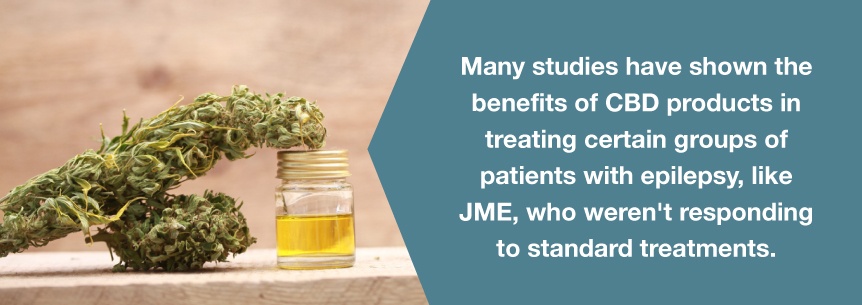
Your endocannabinoid system plays a significant role in the ictal control and neuronal balance. There’s evidence of cannabis and juvenile myoclonic epilepsy derivatives reducing seizure frequencies, according to research published in the journal Innovations in Clinical Neuroscience. There’s also research showing no discernible effect. There are anecdotal reports of success in reducing epilepsy severity, however.
In more recent 1970 animal studies reported in Journal of Pharmacy and Pharmacology, CBD in marijuana for juvenile myoclonic epilepsy treatment showed anticonvulsant effects in mice induced with seizures.
Later studies showed CBD increased the required threshold after one action potential, which made it harder for subsequent potential actions to fire, propagating seizure activity.
CBD has passed through the required pharmacology and safety trials in humans with few concerns or issues. People tolerate CBD well with no substantial adverse reactions or side effects, which you definitely can’t say about anti-seizure medications.
Some individuals report certain side effects with medical weed such as:
These are usually temporary side effects. In some situations, you can even consider them positive side effects. For example, individuals with epilepsy who are having difficulties sleeping are thankful for the sleepiness side effect marijuana causes. And those who have a low appetite and need to gain weight can benefit from cannabis’ tendency to increase the appetite.
Traditional anti-seizure medicines come with many side effects such as:
Medical marijuana and juvenile myoclonic epilepsy treatment can help treat all these symptoms and more.
Breeders all over the U.S. offer over 80 cannabis strains to treat seizures. Charlotte’s Web is one of the better-known strains. It was made for Charlotte Figi to control her seizures. Before using cannabis treatment, she was having over 1,200 seizures a month. After she started using the Charlotte’s Web strain, her seizures went down to two episodes a month.
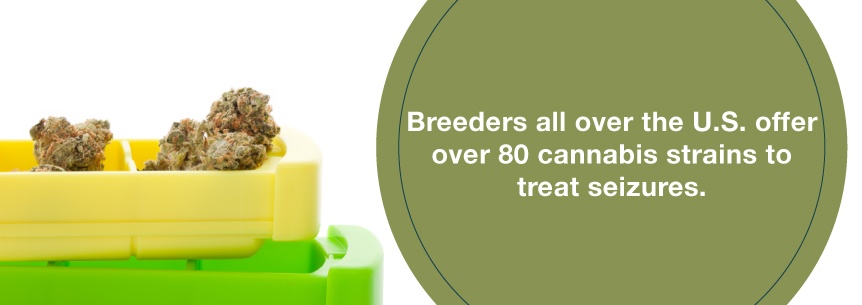
A 2016 Colorado study found that 60 percent of individuals who used Charlotte’s Web reduced their seizure episodes by half and 10 percent became free of seizures altogether.
While Charlotte’s Web is a great strain for seizures, there are others you can try for your JME symptoms, including:
Cannabis for juvenile myoclonic epilepsy is available in a variety of delivery methods. The most often associated method is smoking and produces almost instant effects. However, some patients worry smoking cannabis will affect their respiratory system. So, many other methods grew in popularity and are now readily available wherever such products are legal. Also, smoking marijuana isn’t an option for children who suffer from JME or other forms of epilepsy.
A popular alternative method is vaping. Vaping uses lower temperatures, reducing byproducts made during the process. Medical weed’s chemicals enter your bloodstream rapidly for quick relief with vaping, similar to smoking.
Other methods include:
Most cannabis states allow medical pot use for seizures and epilepsy. If you’re searching for relief from JME or another seizure disorder, MarijuanaDoctors.com can help.
You can connect with hundreds of professional, cannabis-experienced doctors all over the U.S., wherever medical marijuana is legal. Improve your quality of life by booking an appointment today to speak with a highly qualified doctor about your marijuana and juvenile myoclonic epilepsy treatment.
Find A Doctor Find A Dispensary